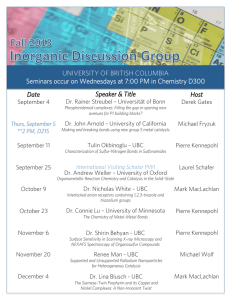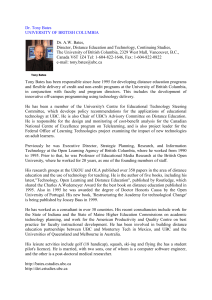Institutional Planning for E-Learning
advertisement
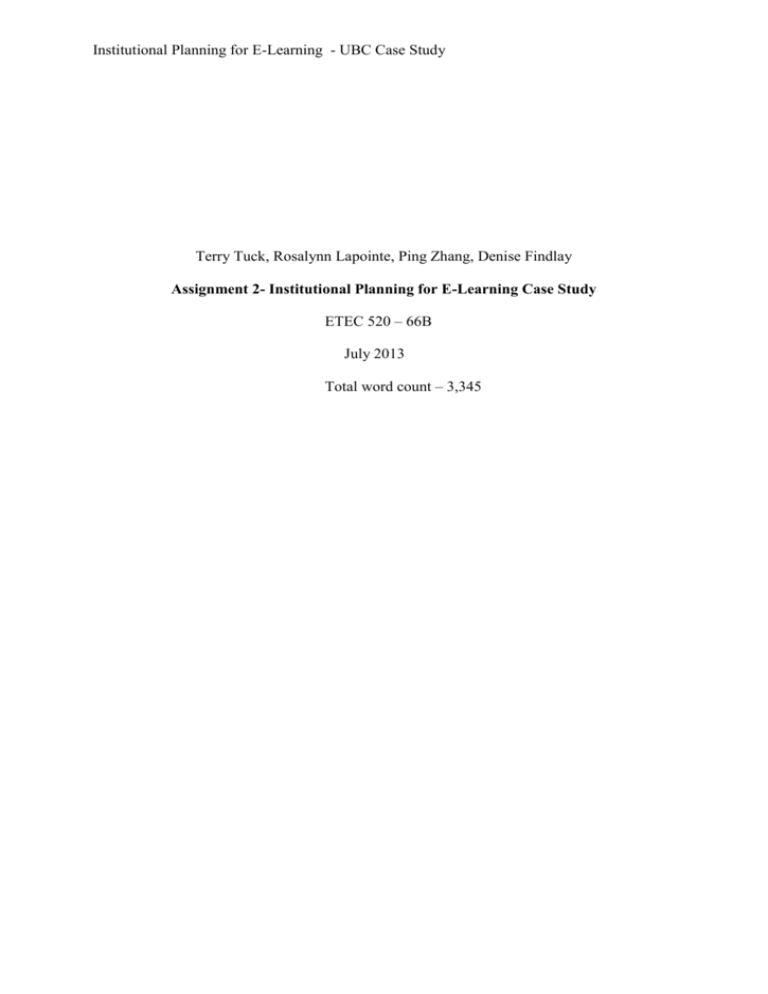
Institutional Planning for E-Learning - UBC Case Study Terry Tuck, Rosalynn Lapointe, Ping Zhang, Denise Findlay Assignment 2- Institutional Planning for E-Learning Case Study ETEC 520 – 66B July 2013 Total word count – 3,345 Institutional Planning for E-Learning - UBC Case Study Introduction The University of British Columbia (UBC) aims to be at the leading edge of e-learning opportunities, and provide quality education for their students. In this essay, we will be examining two strategic planning processes that have influenced e-learning at UBC between 2000 and 2010. We will investigate the strategic plan process surrounding two key documents in relation to the Trek reports that had a major impact on this department. Overview of the Strategic Planning Processes The two planning processes at UBC being considered are: 1. Academic Committee for Creative Use of Learning Technologies Committee (ACCULT) process used to develop recommendations for more effective use of learning technologies on campus. This process resulted in the ACCULT Discussion paper - report to Senate (2000) and the ACCULT final report (2002). 2. The process used to recommend the “Reorganization of distance education at the University” (called the DE&T processs). This process resulted in the Distance Education &Technology (DE&T) Strategic Plan (2002), DE&T External review Report (Anderson et al 2003), DE&T Response to the external review (2003), and the DE&T Provost’s Committee report (McBride 2004) The processes and the events surrounding them are complex. Table 1 (Appendix 1) outlines timeline of events and UBC administration changes and the key events are summarised in Diagram 1. Institutional Planning for E-Learning - UBC Case Study Diagram 1. Timeline of events summarised In 1998 UBC’s Trek 2000 challenged the UBC community to “fully integrate IT in instruction in all areas”. In 2000 the Academic Plan, in line with TREK 2000, advocated a “ strategic plan on how we can facilitate the use of information technology and new media in learning by faculty, staff and students” (ACCULT 2000). At this time UBC had distributed a learning technology (LT) model of Faculty-based LT units and numerous central service units. (Diagram 2) Diagram 2. UBC distributed model of LT in 2000 ACCULT was formed in 2000 by the VP Academic Dr. B. McBride and chaired by Neil Guppy, Assistant VP Academic. This committee, lead by Tony Bates Director of Distance Education and Technology (DE&T) undertook extensive consultation developing a Institutional Planning for E-Learning - UBC Case Study discussion paper in 2000 (The Creative Use of Learning Technologies) with a final report being presented to Senate in 2002. Diagram 3 outlines the processes that lead to the ACCULT Final Report. Diagram 3 ACCULT processes ACCULT created a vision of what UBC could be like in 5-10 years with integration of learning technology and the final report attempted to identify concrete activities that would allow UBC staff to move “forward in creatively using LT”.(ACCULT report 2002 p 10). Their recommendations focused on: changes to funding with recurring funding for faculties with, new revenues, and LTEF proportioned to learning technologies. In 2000 funding for LT through DE&T was a competitive process with the DE fund for undergraduate distance education credit courses (2-3 large projects) and a distance education loan scheme for courses that could fully recover their costs over 5-7 years (total funding $75,000); increasing mixed mode of learning, smart spaces evaluation of LT initiatives; organisation and governance changes with a central Director for creative use of LT, a central facilitation hub, and creation of two university-wide LT committees Institutional Planning for E-Learning - UBC Case Study recognition of LT through awards, career structures and development of an explicit intellectual property policy for LT. Following the ACCULT report (2002) recommendations the focus was on the development of a faculty-based, centrally-supported model for distance learning at UBC. However there were two very different approaches proposed to achieve this: 1. The DE&T unit developed a 5 year plan to evolve DE&T from an autonomous unit to a Teaching and Learning Support Network (TLSN) more integrated with other central units (TAG, Telestudios, OLT, MAPLE etc) and faculty LT units. The aim of this network hub would be to provide leadership to faculties and administrative units to develop their expertise and skills in LT with the aim that Faculties increase their development and delivery of mixed mode and distance delivery (through their own Learning Support Units). The staff of the TLSN would work mainly within the faculty on a project basis. (DE&T Plan 2008) Diagram 4. DE&T’s suggested Teaching and Learning Support Network. (Adapted from DE&T Plan 2008.) Institutional Planning for E-Learning - UBC Case Study 2. An external review of DE&T was organised by the Vice President Academic’s office in 2003, stated to be part of the regular department reviews M. Bullen (personal communication, 8 July 2013). This resulted in DE&T moving from reporting to Associate VP Continuing Studies to the Associate Vice President, Academic Programs. Following this external review the VP Academic & Provost established a Committee to follow up the recommendations of the external review. The report of this committee; while recognizing the “professionalism, dedication, knowledge and responsiveness” of the DE&T staff and the “high standards and cost effectiveness” using effective project management techniques under the expertise of their “globally recognized” director, Dr. Tony Bates, who was due to retire shortly; recommended the “evolution” (actually dissolution) of the DE&T unit with staff and funding being absorbed by Faculties or other centralised UBC units (revenue neutral to the university’s central budget). (Provost’s Committee 2004) The expectation was that this would shift the responsibility for distance education to the Faculties Bates and Sangra (2011, p.144) also comment that the DE&T unit was to be closed down by senior management because it was not considered to be an academic department. Of note, in 2003 there was also a change in VP Academic which saw the move of Dr McBride to UBC Okanagan and Lorne Whitehead appointed in his place. Dr McBride later resigned. In 2004 the decision was that the recommendations of the Provost’s Committee were to be implemented, and a transition plan put in place. However, in March 2005, a decision was made not to progress with the dissolution of DE&T. The correspondence from the Associate VP Academic Programs identified “a number of complications... (that have arisen)... in the last couple of weeks that throw into doubt the original assumptions on which the decision to decentralise DE&T was made” (letter March 21, 2005). In April 2005 the DE&T unit was Institutional Planning for E-Learning - UBC Case Study merged with the Office of Learning technologies (OLT). All staff except the position of DE&T Director were maintained. There is no description of what the ‘complications’ were, but staff at the time believed that the Faculty Deans had become aware of the financial implications of the change and that despite reallocation of revenue it was likely that they would, at best, break even whilst losing the benefits of scale a centralised unit provided M. Bullen (personal communication, 8 July 2013). It was not until 2010 that any further changes to the organisational structure in the learning technology area was made. Unable to find a replacement Director for the Centre for Teaching and Learning (CTL – previously TAG) with both academic and administrative management skills other possibilities were considered. The final decision was to merge CTL and OLT with the creation of the Centre for Teaching, Learning and Technology (CTLT). At this same time the Learning Technology Advisory Council (LTAC) was formed. Thus by 2010 there was one central unit providing learning technology, instructional design and faculty support in learning technologies (diagram 5). Diagram 5. CTLT 2010 to current Institutional Planning for E-Learning - UBC Case Study Critical analysis of processes This review of UBC’s processes demonstrated Bereiter and Scardamalia’s (2011) concepts of waves of technology implementation. The initial focus of TREK 2000 and the ensuing Academic plan for information and communication technology (ICT) seems to fit into wave 1 - where technology is seen as an imperative. By the ACCULT Final Report (2002) the approach seems to have moved into wave 2, adoption of ICT but using it appropriately in learning. Finally wave 3 ICT as affordances is apparent in the DE&T Plan 2008 and certainly widely embraced with the formation of CTLT. The Leadership Bates and Sangra (2011) identify the importance of leadership for institutional e-learning integration, but highlight that this also requires the support and involvement of a wide range of stakeholders. While proceeding through the ACCULT process, the Academic Plan created during Trek 2000 was the guiding force to ensure that ACCULT was matching the needs of the university. The process appears to be motivated by UBC executives but also with Faculties, staff and students creating a vision for the whole of UBC. This integration of technology to enhance teaching would support students and their learning, the Faculty body would be replenished as new quality candidates would be attracted to the state of the art facilities, equipment and support provided for their teaching and research interests. This modern, new age institution would be in a better position to attract ‘excellent’ students from around the world as suggested in the Trek reports. As a result UBC would most certainly be attractive to potential donors, investors and funding agencies providing it with a bright, strong future as one of Canada’s top educational institutions. The DE&T process, focusing on the reorganization of distance education, appeared to be motivated by the needs of three distinct groups – DE&T unit, VP Academic & Provost, and Institutional Planning for E-Learning - UBC Case Study Faculties. It would seem that technology was being implemented over the campus in different forms and with varying degrees of support, varying degrees of quality and with overlapping and duplication from a multiplicity of services. DE&T saw a need to develop a unit action plan following the recommendations of ACCULT. The VP Academic &Provost needed to develop a structure to further develop and support distance education budgetary costs were under control and the retention rate of expert staff stayed high to best serve the faculty, the students, the administrative processes in an efficient manner. The imminent retirement of the DE&T director, may have caught the attention of the VP Academic as a starting point for review. The Faculties needed to build LT expertise in distance education and delivery, and appeared to want recurring faculty funding to support this rather than the limited project oriented budgeting that DE&T imposed. In the ACCULT process both leadership and wide stakeholder support are present. In the DE&T process there is an imminent loss of leadership for DE&T, and the initial leadership and stakeholder direction and views are divided. As the process unfolds there are also the disruptions of executive leadership changes and change of focus to other major events eg Okanagan University College dissolution with the creation of UBC Okanagan. The Strategic planning Bates and Sangra (2011) also highlight the importance of strategic planning for technology integration and argue that strategic thinking not just planning is more important - that is thinking “about the way technology could transform the organisation” (p101). They outline six recommendations; 1. The strategic importance of technology (and financial implications) needs to be recognised across the organisation and by key staff 2. Compelling visions and goals need to be developed for the institutions use of technology to transform the institution. 3. Planning must involve faculty and staff in the strategic thinking. Institutional Planning for E-Learning - UBC Case Study 4. All members of the executive team must fully support the strategy on a continuing basis 5. Technology planning needs to be an ongoing process and part of an institution’s future planning 6. The strategic direction for technology needs to be linked to each faculty/department through the annual academic planning and budgets These recommendations provide a useful scaffold from which to assess both the ACCULT and the DE&T processes. Both processes were focused on following the vision provided in TREK 2000. The planning that occurred during the ACCULT process was coordinated and the various stages flowed, with little disruption. While the process commenced as a top down approach with the establishment of the ACCULT committee, the committee itself undertook a campus wide consultative process with Faculties, staff, students, external organisations involving them in the strategic thinking. They also continued to include input from the executive (the VP & Provost and the Senate) in an effort to maintain the members support for the strategy (Diagram 3). In this way they ensured the strategic importance of technology was recognised across the organisation. Both ACCULT papers were rich with visions and goals for the future and the strategic direction identified in the final report also focused on funding at central and faculty levels, and organisation and governance change. The process also included an environmental scan identifying both external and internal problems and issues, thus the individual recommendations of the ACCULT final report were reported in a very practical way by recognising the importance of strategies that UBC was already employing, but also identifying ‘new’ or different strategies that need to be employed. These were wide ranging and specific strategies that were consistent with TREK 2000. Institutional Planning for E-Learning - UBC Case Study Supported by UBC executive and implemented campus wide by central and faculty units within their own unit plans they would have resulted in improved practice and service to learners. Overall, Bates and Sangra’s (2011) six recommendations were integral to the strategic planning and thinking process of ACCULT. The processes that occurred during the DE&T strategic planning process were less coordinated (indeed chaotic). The DE&T Plan, while not widely consultative, was a unit based strategic plan in response to ACCULT and thus an appropriate next step for the unit itself. The DE&T plan provided a concrete approach to the devolution of the independent DE&T unit to a smaller unit whilst building the faculty expertise. However, the concept of the TLS Network, as a central component of this plan, still had the risks of multiple units providing overlapping functions and duplication of services with co-ordination through committee. The VP & Provost approach was a top down approach and partially consultative, with appointment of an external review panel (who did interview 55 faculty members) and a high level review committee. The DE&T External Review report provided clear recommendations that were mainly focused on the role of the DE&T unit. Only one recommendation specifically commented on further campus-wide consultation which had begun with ACCULT. The report suggested a balance between centralisation and de-centralised approaches. This balance aimed to maintain the expertise and resources of a central unit, whilst developing faculty skills and knowledge and ultimately delivering cost efficiencies in development of resources. Overall the external review seemed to be in line with the ACCULT final report, the DE&T Plan and thus TREK 2000. The VP Academic & Provost’s Committee report however, is somewhat at odds. This report is based on the VP Academic Institutional Planning for E-Learning - UBC Case Study & Provost’s main focus (a line from the external review committee report) that “a distributed approach centred on the Faculties is to be preferred.” The Committee recommendations were also very focused on funding models. Overall, many of Bates and Sangra’s (2011) recommendations for effective strategic thinking and planning were missing in this disjointed DE&T process. Bradmore and Symyrnios (2009) (in Bates and Sangra 20011, p.86) identify that strategic plans made available to the general public do not in reality reflect the true plans or concerns of the university leadership and that there are often three versions, the published publically available version that tends to avoid provocative issues, a more detailed version with relatively sensitive information, made available to staff on a need to know basis, and an even more sensitive and confidential plan that might be committed to paper but resides in the heads of senior administration. From TREK 2000 through ACCULT and the DE&T processes one wonders what was residing in the heads of senior administration at UBC. The DE&T decision While the VP Academic & Provost’s Committee recommendations appear to be consistent with the strategic plan TREK 2000 in their attempt to develop the faculties and increase blended and online courses delivery, the recommendation for dissolution of the DE&T removes a highly functional development and online delivery unit that also provides central expertise and support for faculties. Devolving unit staff into faculties would provide the faculties with expertise, but there was also the potential loss of efficiencies from a central unit, loss of expertise that attracts external grants, loss of a collegial space for staff of DE&T and potentially reduced student support for those undertaking online courses previously through DE&T. These recommendations could have resulted in a reduction in the ability to deliver on improved practice and service to learners in the short term. If DE&T staff had left UBC because of the complete dissolution of the DE&T there would have been a dramatic Institutional Planning for E-Learning - UBC Case Study reduction in the ability to deliver on improved practice and service to learners in both the short and medium term. The aftermath The cancellation of the decentralization plan announced on March 21, 2005 may have been in part a result of leadership changes, and a recognition that faculty funding changes would not result in a surplus of funds, but most importantly also seems to have been a recognition of what the DE&T unit provided to faculty and students and what the potential impacts of the dissolution of the DE&T unit might be (as described above). The subsequent takeover of DE&T by OLT confirmed the DE&T external review and, in part, the DE&T Plan - allowing for the development of a faculty-based, centrally-supported model for distance learning at UBC. It was also consistent with TREK 2000 and the ACCULT final report, The expertise and efficiencies of DE&T was kept intact and the two units could “consolidate and rationalize their complementary services campus-wide” (Kindler, 2005). A combined DE&T and OLT, could continue to provide co-ordinated central support whilst still directly supporting the development of Faculty expertise and increased Faculty distance learning delivery in an efficient and sustainable way. Creation of CTLT While the merger of OLT with TAG in 2010 to create the CTLT might seem to be the result of failure to find a new director, it was much more a recognition of the common view in the university that the various departments who shared responsibility for learning technology, instructional design and faculty support should be brought together to achieve better efficiencies and synergies. The previous merger of OLT with Telestudios had strengthened this view. Bates and Sangra (2011) quote Davis 2008 (p.124), that “the centralised versus decentralized approach no longer aligns well with the programmatic objectives and Institutional Planning for E-Learning - UBC Case Study regulatory requirements of the university” and argue that both are needed to meet the needs of the institution and the needs of the end users. The ACCULT Report recognised this in 2002 with its recommendations for the development of a faculty-based, centrally-supported model for distance learning. Thus the creation of CTLT was a solid step to achieve the development of a faculty-based, centrally-supported model for distance learning at UBC first identified in ACCULT 2002. While different in structure, with one combined unit, it also was consistent with elements of both the DE&T Plan in 2002 and the DE&T External Review in 2003. It recognized that modern education is an inseparable integration of technology with the teaching and learning process. It was the creation of one central unit that provided learning technology, instructional design, professional development and support for faculties, whilst also delivering research-informed online courses and student support in its own right, and also investigating, developing, piloting and evaluating educational technologies. Diagram 5 demonstrates how CTLT delivered all the functions of each of the UBC Units of the past, and from current CTLT website, we find it is delivering even more – eg providing leadership and support for strategic curricula and pedagogical initiatives through the Institute for the Scholarship of Teaching and Learning, and supporting and supporting First Nation Aboriginal initiative. Conclusion A review of the ACCULT process at UBC revealed a strategic planning process that followed Bates and Sangra’s (2011) six recommendations. The outcome was an effective plan for more effective use of learning technologies on campus. The DE&T process for the reorganisation of distance education demonstrated the problems of predominately top down strategic planning approaches, changes to executive teams that disrupt the continuity of support required for strategic planning, and administrators making Institutional Planning for E-Learning - UBC Case Study decisions in areas where a unit (or committee) may have more expertise and knowledge but have no decision making power. The UBC e-learning story, is also an example of a university grappling with a centralised versus decentralised approach and identifying that both approaches are required. Institutional Planning for E-Learning - UBC Case Study References Academic Committee for Creative Use of Learning Technologies Committee. (2000). Discussion paper of the academic committee for the creative use of Learning Technologies; Executive summary. Retrieved from: http://www.box.net/shared/fgxzxbtaiu Academic Committee for Creative Use of Learning Technologies Committee. (2002). Advancing the Creative Use of Learning Technology. Retrieved from: http://www.box.net/shared/tibjvr27i9 Anderson, T., Hartman, J.L., Stanton, S. J., & Pratt, D. (2003). Visiting Team Report, Distance Education and Technology Review. Retrieved from: http://www.box.net/shared/k17njzlnmc Bates, A.W. (2007). Strategic Planning for E-Learning in a Polytechnic. In M. Bullen & D.P. Janes (Eds.) Making the Transition to E-Learning: Strategies & Issues (pp. 47-65). Hershey, PA: Information Science Publishing. Bates, A.W. & Sangrà, A. (2011) Managing technology in higher education: strategies for transforming teaching and learning. San Francisco, CA: John Wiley and Sons. Bereiter, C. & Scardamalia, M. (2006). Catching the Third ICT Wave. Queen’s University Education Letter. Bullen, M. & Janes, D.P (2007). Making Transitions to E-Learning: strategies and Issues. Hershey, PA: Information Science Publishing. Institutional Planning for E-Learning - UBC Case Study Centre for Teaching, Learning & Technology. (2013). Retrieved from: http://ctlt.ubc.ca/ Distance Education & Technology. (2000). Project Development Manual for Faculty: Developing Distance Education or Distributed Learning Courses. Retrieved from: http://www.box.net/shared/b5tzvdlds9 Distance Education & Technology. (2002). A strategic plan for distance education 2008. Retrieved from: http://www.box.net/shared/j2xpgaeiq8 Distance Education & Technology. (2003). Response to the External Review of Distance Education & Technology. Retrieved from: http://www.box.net/shared/phoq4j9v0x Learning Technology Advisory Council. (2013, July 12). LTAC Terms of Reference. Retrieved from: http://blogs.ubc.ca/ltac/terms-of-reference/ University of British Columbia Office of the President. (2000). Trek 2000 the story so far… 2000-2001 report . Retrieved from: http://www.vision.ubc.ca/reports/trek_report_2001.pdf University of British Columbia Office of the President. (2000). Trek 2010.Retrieved from: http://www.vision.ubc.ca/index.html University of British Columbia Office of the President. Archives http://president.ubc.ca/ University of British Columbia Public Affair. Annual Reports http://www.publicaffairs.ubc.ca/ University of British Columbia Vice President Academic &Provost Committee. (2004). Report of the Committee to Consider the Evolution of the Distance Education and Technology Unit at UBC. Retrieved from:http://www.box.net/shared/ks7963xcf0 Institutional Planning for E-Learning - UBC Case Study APPENDIX 1 UBC Change timeline 2000-2010 Institutional Planning for E-Learning - UBC Case Study
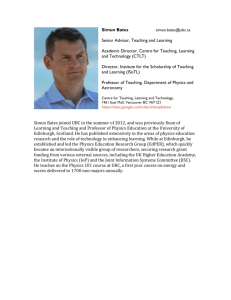

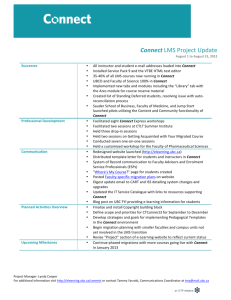
![July 31 Connect eupdate DRAFT [1]](http://s3.studylib.net/store/data/008100166_1-21bd0e395dcbfd67aaad5f18dd4ec08e-300x300.png)


